MICROPHONES
Introduction
The microphone is the fundamental tool of the investigator of ultrasonic bioacoustics. Its quality determines the diversity of signals which he is capable of detecting and, in association with its associated electronics, the range at which they can be detected. It should therefore have as wide a bandwidth as possible, a flat frequency response so that reasonable analysis of the relative levels of different parts of a signal can be made, and should be sufficiently robust to withstand use in the field or in close proximity to animals.
Some of the first attempts to detect animal ultrasound were made by Lutz, with the assistance of Westinghouse Electric and Manufacturing Co., but these were unfortunately unsuccessful.
The physicist G. W. Pierce did succeed however, using two different types of transducers (Noyes and Pierce 1938, Pierce 1948). The first type of transducer was a piezoelectric device, using a crystal of Rochelle salt, while the other consisted of a rod of nickel alloy, using the principle of magnetostriction.
Both of these types of microphones suffered from poor sensitivity due to the impedance mismatch into the air, although this could be overcome to some extent by fitting a parabolic horn. The improvement in sensitivity is achieved only at the cost of increased directionality, so that it becomes important for the microphone to directed accurately towards the sound source (Griffin 1958).
These microphones are inherently tuned devices and are therefore far more sensitive at their resonant frequency than at any other frequency. By using them in an untuned circuit at frequencies well below resonance a fairly flat frequency response can be achieved, but use in this way also reduces sensitivity considerably. A more suitable form of transducer is the capacitance microphone.
Basically this consists of a charged capacitor, one plate of which is a flexible diaphragm. As the incident sound pressure causes the diaphragm to move the capacitance changes which, if the charge is constant, causes a change in the voltage appearing across the capacitor.
The construction of a simple capacitance microphone is shown in fig. TR1. A light metallic diaphragm is supported in front of a metal backplate, from which it is separated by a dielectric. In this case air. A small breather hole leading to the airspace behind the diaphragm allows equalisation of the air pressure, but may be sealed off if the microphone is to be used for very low frequencies.

This form of construction is used by Bruel Kjaer in their range of calibrated microphones. These microphones are very constant in their characteristics and are available with wide frequency responses, but they are very fragile and are therefore not very suitable for field use.
A capacitance microphone needs to be charged for correct operation. Usually this charge will be provided by a voltage source with a very high output impedance so that the charge on the microphone will remain essentially constant. The higher the polarising voltage the greater the change in voltage for a given sound pressure. However, the voltage which can be used is limited by the breakdown voltage of the dielectric. A polarising source of about 200 Volts is usually adequate for most ultrasound microphones.
The polarising voltage is most conveniently generated by using a small step-up transformer driven by a low power oscillator. A voltage doubler may be used in the rectifier circuit, followed by a two or three stage low pass RC filter circuit. A high value series resistor, typically of about 100 Megohms provides the necessary output impedance.
The need for a polarising voltage generator may be obviated by the use of the electret principle. A dielectric film may be treated so that a charge will be more or less permanently fixed. This may be done by heating a charged dielectric or by bombarding it with a high energy electron beam. Not all dielectric materials are equally suitable for use as electrets since they vary in their charge retention characteristics, and it is very difficult to produce consistent reliable electrets with simple equipment. The technique is therefore not suitable for hand-made, or low volume production microphones, but has been used successfully for the manufacture of small hearing aid microphones.
The capacitance microphone also requires a very high input impedance amplifier (fig. TR2a), which must be located very close to the microphone itself. This is because the sensitivity is proportional to E.δC/C, where E is the polarising voltage, δC is the change in capacitance cause by the incident sound pressure, and C is the resting capacitance of the microphone, plus any stray capacitance to ground. It is clear that this stray capacitance must be kept to a minimum and the amplifier is therefore usually built into the microphone mounting.
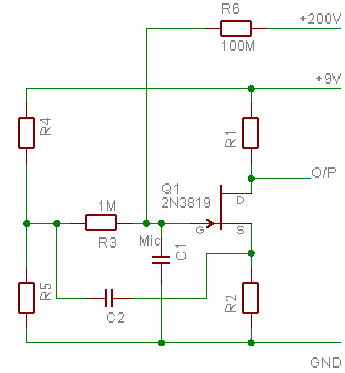
An alternative approach to headstage amplifier design is to use a charge amplifier (fig. TR2b). In this case the voltage across the capacitor is held constant and the charge is allowed to change. The advantage of this design is that the sensitivity is not affected by stray capacitance between the signal lead and ground, since the microphone terminal is at a virtual earth. However, the gain of the system is proportional to the ratio of the change in capacitance of the microphone to the feedback capacitor (C2). The feedback capacitor must therefore be very small. Since the low frequency cut off is determined by the feedback resistor and capacitor, the feedback resistor will therefore have to be very large, and the amplifier must therefore have very low bias current. For this reason it is more common for the high input impedance amplifier design to be used.
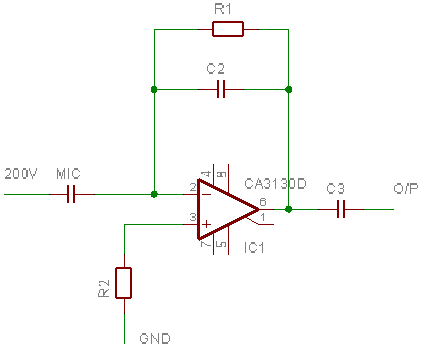
Fig. TR2b Charge Amplifier Headstage
In 1948, Rudnick and Stein calibrated the WE640AA audio capacitance microphone up to a frequency of 100 kHz, using the technique of reciprocity (Foldy and Primakoff 1945, Maclean 1940, Olson 1941, Ballantine 1929), which obviates the need for a transducer which has already been calibrated over the required range. The fundamental resonance of this microphone occurs at about 10 kHz, and above that the sensitivity drops at a rate of 12 dB/octave (fig. TR5a). The sensitivity at 100 kHz is 33 dB less than at 1 kHz, and 38 dB less than at 10 kHz. The overall sensitivity, however, is sufficiently high (-50dB re 1V/µbar at 1 kHz) that it is still better than crystal or magnetostrictive devices.
This type of microphone was used by Griffin and his co-workers in studying bat ultrasound until the late 1950’s (Griffin 1958). A slight problem with this microphone at high frequencies is the presence of two anti-resonant dips at 31.5 and 38 kHz. These are due to resonance in the chamber behind the diaphragm and can be eliminated by filling the cavity with hydrogen, thus shifting the anti-resonances to above 100 kHz, or by filling the cavity with a fine silk grid, thus damping them to a negligible level. A high frequency version of the microphone was also produced in which the diaphragm was stretched more tightly. In this microphone sensitivity is about 3 dB better at frequencies above 25 kHz and 3 dB less at frequencies much below 25 kHz.
In 1954, Kuhl, Schodder and Schroder published the results of extensive investigations into the design and properties of capacitance loudspeakers and microphones. Since the transducers are reversible the characteristics of transducers used as loudspeakers will reflect the properties of microphones of a similar design.
Using loudspeakers Kuhl et al looked at the effect of backplate design and polarising voltage, and measured the linearity of the transducers using various types of diaphragm material.
If smooth or sandblasted backplates are used the diaphragm compliance, which is dependent upon its ability to move, is so small that the resonant frequency of the transducer becomes very high, and the transmitted sound energy is very small. For resonant frequencies below 100 kHz a backplate with grooves machined in it allows increased compliance and greater sound production.
Increasing the diaphragm tension reduces the compliance of the diaphragm leading to a drop in efficiency, but an increase in frequency response. Polarising voltage can also affect the diaphragm compliance by changing the tension as the diaphragm is pulled down onto the backplate. The extent to which this happens however is dependent upon the degree of roughness of the backplate.
For microphones the frequency response was found to depend upon the mass of the diaphragm per unit area, the flexural compliance of the diaphragm, its mechanical pre-strain, and the compliance of the air cushion between the diaphragm and the backplate. The absolute sensitivity was found to depend upon the bias voltage, the nature of the surface of the backplate, and the compliance of the diaphragm, which is largely determined by the mechanical pre-strain.
The linearity of the transducers when used as loudspeakers depends on the type of diaphragm material used. A polystyrene diaphragm gives perfect linearity, but when the diaphragm is made of polyethylene there is a 2.0-2.5 dB deviation from linearity.
An investigation of the effects of various types of backplate, with diaphragms of polyethylene or polyester (Mylar) was carried out by Matsuzawa in Japan (1958). He used two classes of backplates, those with finely roughened surfaces, and those with coarsely roughened surfaces. The latter group consisted of backplates with a wide spiral groove (1.5mm wide and .1 mm deep), or with four holes 2 mm diameter and 2mm deep. Microphones made with the coarsely roughened group of backplates were found to be unacceptable due to the presence of large anti-resonant dips in the frequency response.
The finely roughened backplates were divided into two sub-groups. The first with the surfaces roughened with sandpaper, lightly scribed, prickpunched or provided with a shallow spiral groove about 0.5mm in width and the second with arrays of small hollows of various sizes from 0.25mm to 0.9mm in diameter and 0.1mm to 0.4mm in depth.
Matsuzawa found that microphones with the finely roughened backplates behaved as single resonant systems with a resonance frequency inversely proportional to the square root of the surface density of the diaphragm, but this relationship did not hold for the microphones with coarsely roughened backplates, or for the microphone with a backplate which had 0.9mm diameter, 0.4mm deep holes in it.
The resonance frequency was also found to be higher for microphones with backplates which had a finer surface texture.
The effect of diaphragm tension was found to be rather variable, but in general an increase in tension led to lower sensitivity, but a higher frequency response. Below a certain tension however. the effect was negligible.
A microphone with a diaphragm of 13 µm polyester and a backplate with 500 small hollows, 0.25mm diameter and 0.1mm deep, had a high frequency resonance of 150 kHz and a sensitivity of -79.5 dB re 1V/µbar (-59.5dB re 1V/Pa).
Granath produced a microphone similar to those used by Kuhl et al, on a commercial basis (McCue and Bertolini 1964) and this was used with the Lincoln bat detector.
Pye and Flinn (1964), managed to simplify the mechanical construction of the microphones, and avoided the problem of having to accurately machine circular or spiral grooves in the backplate by cementing a watch balance spring to a perspex disc. An even simpler design using the same backplate but with a fixed rather than an adjustable diaphragm tension was also described, but never entered general service.
Pye later replaced the watch balance spring with a disc of mild steel perforated with an array of small holes, cut from the shadow mask of a colour television tube (Pye 1980).
The frequency response of a capacitance microphone may be accounted for by reference to its equivalent electrical circuit, in which the acoustical and mechanical components of the microphone are represented by their electrical analogues. The equivalent circuit of the WE640AA microphone has been analysed by Beranek (Acoustics - 1954), and is shown in Fig TR6.
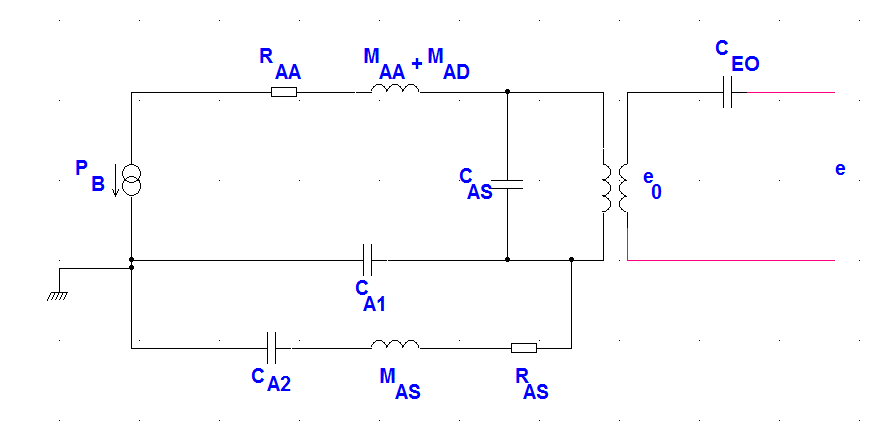
The source, PB, is the pressure that would be present at the diaphragm if the diaphragm was not able to move, and e0 is the open circuit output voltage of the microphone. The inductances are equivalent to acoustic masses, each of which can be represented as a volume of air enclosed by a hollow tube of length L and cross-sectional area S.
The acoustical mass MAD is due to the mechanical mass of the diaphragm (MMD) divided by the square of its effective surface area. This is coupled with the mass MAA which is due to the radiation impedance looking out from the diaphragm (Z), where:-
Z = j ω MAA
and MAA = 0.1952 ρ0 / a kg m-4
for the case of a piston vibrating in the end of a long tube
where a is the radius of the diaphragm.
The resistive component of the radiation impedance is RAA.
The third acoustical mass, MAS, is due to the slots and grooves in the backplate, with a corresponding resistance RAS.
A capacitance may be represented in one of two ways. If one side of the capacitor is grounded it is equivalent to a volume of gas that is compressed without moving. For example a closed tube. Alternatively a floating capacitance may be due to a stiffness controlled diaphragm.
The capacitance CAS represents the compliance of the diaphragm per unit force. CA1 is due to the air gap behind the diaphragm, which permits the diaphragm to move; the same space which is responsible for the acoustical mass MAS. Finally there is a further air gap around the backplate which gives rise to compliance CA2.
The remaining element of importance is the transformer, which has a ratio of 1:E CAS/x0S, where E is the polarising voltage and x0 is the distance between the backplate and the diaphragm.
Although it might seem that it would be possible to use the equivalent circuit to design a microphone with any reasonable set of characteristics, it is in practice very difficult to accurately quantify many of the variables involved. It is however possible to explain the frequency response obtained from a given microphone, and a knowledge of the equivalent circuit may then suggest areas where the design may be changed so as to optimise the microphone’s characteristics.
For the WE640AA microphone (Fig TR6) the impedance of the inductive elements is negligible at low frequencies and the circuit becomes a potential divider consisting of CA2 and CAS giving a flat frequency response, with the sensitivity proportional to the ratio of the two capacitances. A first resonant peak occurs when the impedance of MAA, MAD and MAS is equal to that of CAS in series with CA2.This resonant peak is damped by RAS to an amplitude of about 3dB. Above this frequency the three inductors form a potential divider with CAS giving a roll off of 12 dB/octave. At about 38 kHz there is a sharp anti-resonant dip due to the parallel combination of MAS and CA1. Just above this there is a small resonant peak produced by the series combination of MAA + MAD with CAS, which is damped by RAA which is no longer negligible compared to jwMAA. Above this the frequency response continues to fall at 12 dB/octave.
It will be shown later that this equivalent circuit is also sufficient to account for the somewhat different frequency response of the new QMC microphone.
When commercial production of the new S100 bat detector was planned a need arose for a suitable microphone. The main requirements were that it should have a frequency response which was flat within +/- 3dB from less than 20kHz to above 100 kHz, it should be at least as sensitive as the currently available microphones and that it should be as cheap as possible to manufacture. The last condition implies that there should be good consistency between different microphones. Also, since the microphone was intended for field use it should be as rugged and reliable under adverse conditions as possible.
Microphones of the same design as used by Kuhl et al, and which were also used in the Holgate bat detector were considered unsuitable due to the mechanical complexity involved in their construction. The number of component parts is high and the backplates require careful and accurate machining.
Pye and Flinn’s ‘brass’ microphones, while reducing the structural complexity considerably, and eliminating the problem of machining the backplate were considered to be still rather complex, and labour intensive in their assembly. It was also considered that there was too much variability in sensitivity and frequency response between one microphone and another, or even for one microphone with a new diaphragm fitted, for a reliable commercial product. However the microphone which they described with fixed diaphragm tension was used as a basis for the mechanical design of the new microphone.
Very few microphones were available commercially for use in the ultrasonic range, although some transducers were made for use in ultrasonic remote control units for televisions. One such microphone was tested but was found to have an unsatisfactory frequency response.
Electret hearing aid microphones were also considered since they have the great advantage of not requiring a polarising voltage generator. However, although high frequency versions were described in the literature these were no longer commercially available, and those microphones which were available had frequency response extending only to 15 kHz. These microphones have been used in the tuned QMC Mini bat detector, but for applications where a wide bandwidth was required they were not considered suitable. Although the frequency response could be tailored with suitable filter networks, this has the effect of reducing the overall sensitivity of the microphone.
Materials and Methods
A number of techniques exist for the calibration of microphone sensitivity. Two common techniques used for the calibration of commercial capacitance microphones are the pistonphone, and the electrostatic actuator.
The pistonphone consists of a sealed chamber with the microphone fixed at one end. By varying the pressure within the chamber and measuring the voltage produced by the microphone the pressure response can be measured. The electrostatic actuator is specifically for the calibration of capacitance microphones, and is capable of working to much higher frequencies than the pistonphone. A rigid metal perforated screen is accurately positioned close to the diaphragm of the microphone and an alternating voltage is applied between the diaphragm and the screen. The electrostatic force between these plates causes the diaphragm to move and the output of the microphone can be measured.
Both of these techniques require equipment that is designed and manufactured to very fine tolerances, and which is closely matched to the microphone to be tested. Also, they are used to measure the pressure response of the microphone, rather than the free-field response, and a free-field correction factor must then be determined. Neither of these techniques are therefore suitable for the calibration of a diverse range of existing and experimental microphones.
A more generally useful technique is that of reciprocity (Foldy and Primakoff 1945, Maclean 1940, Olson 1941, Ballantine 1929). This is based on the principle that if a transducer is reversible, that is it can be used both as a microphone and as a loudspeaker, then its sensitivity as a microphone at a given frequency is proportional to the sound pressure produced at that frequency when used as a loudspeaker and to the current required to produce the sound. This reciprocity relationship, while true of the majority of reversible transducers, is not universally true of all transducers (Foldy and Primakoff 1945) and their is no simple criterion by which it is possible to determine whether a specific transducer obeys the reciprocity laws.
The technique requires three transducers, one loudspeaker, one reversible transducer which obeys the reciprocity laws, and the microphone to be calibrated. It is not necessary to know the frequency response of any of the three transducers. With the loudspeaker (A) driven at constant voltage, the output of the reversible transducer (C) used as a microphone is measured (VCA), and the output of the microphone (B) is measured (VBA). The loudspeaker is then replaced by the reversible transducer and the output of the microphone (B) measured (VBC) as well as the current driving the loudspeaker (IC). The sensitivity of the microphone can then be calculated from:- .fig 5 where pc is the specific acoustic resistance of air, a is the acoustic amplitude absorption coefficient of air and d is the distance between the loudspeaker and the microphone.
SB = 10-7/2 [( (VBA VBC 2d) / (IC VCA pc) ) ead ]1/2
Rudnick and Stein (1948), showed that it is possible to determine whether a pair of reversible transducers obey the reciprocity theorem by measuring the output from each in response to a known driving current in the other. It was found that the microphones described here do not obey the reciprocity laws, and it was therefore not possible to use this calibration technique. The reason for the lack of reciprocity was not determined, but may have been due to non-linearity, as observed by Kuhl et al when using a Mylar diaphragm.
Experimental and production transducers were calibrated against a B&K ¼” calibrated microphone. Experimental microphones and loudspeakers were calibrated in the QMC anechoic chamber (Ellison and Miller 1963) and production microphones were calibrated on an open bench in the centre of a large room.
For loudspeaker calibrations the experimental transducer was fixed in the centre of the anechoic chamber, and the B&K ¼” microphone, connected to a headstage amplifier type 2615 or 2619 by an adaptor type 0035 was attached to the centre of a vertical semi-circular arm at a distance of 40 cms from the loudspeaker. The loudspeaker was driven by a valve amplifier via 2m length of co-axial cable. The loudspeaker amplifier was located within the chamber while the driving signal came from a Venner signal generator type TMA625/2, located outside the chamber. The loudspeaker was normally driven by a constant voltage of 10 V r.m.s. which was measured at the loudspeaker terminals by a Levell microvoltmeter type TM3A, the output signal of which could be monitored from outside the chamber. For performing reciprocity checks the current through the loudspeaker could be monitored by measuring the voltage drop across a 10 ohm resistor in series with the loudspeaker.
The same arrangement was used for the calibration of experimental microphones, except that the ¼” B&K microphone and adaptor could be replaced by the experimental microphone attached to an adaptor type JJ2614. Complete responses for the standard and test microphones were obtained alternately, and the means of three responses in each case were taken.
Routine calibration of production microphones was performed by positioning the standard microphone next to the test microphone and taking readings from both simultaneously. The loudspeaker and microphones were positioned 30 cms above bench height, with foam wedges on the bench top and attached to the loudspeaker and microphone stands to reduce reflections. The test microphone, mounted in a QMC Instruments headstage, was held in a clamp stand with a ¼” B&K microphone and headstage held next to the test microphone with its diaphragm slightly in front of the front ring off the test microphone to prevent shielding. The loudspeaker was held in a clamp stand at the same height and at a distance of 30 cms from the microphones. The loudspeaker was aligned by transmitting a high frequency signal (about 180 kHz) and rotating the loudspeaker to a point midway between the positions for which the outputs of the two microphones were greatest. This technique is adequate for frequencies up to 120 kHz.
The loudspeaker was driven by a valve amplifier as before, with a Farnell function generator type FG1 as the signal source. Microphone signals from both standard and test microphones were filtered with 1kHz high pass passive RC filters, and measured on Levell TM3A microvoltmeters. The outputs of the microvoltmeters were monitored on a Telequipment D63 oscilloscope.
At each frequency the loudspeaker drive signal was adjusted to give a nominal sound pressure of 51 dB SPL as measured by the B&K microphone, and the corresponding reading for the test microphone was recorded. When calculating the final frequency response of the test microphones corrections were included for the frequency response of the B&K headstage amplifier and microphone and the frequency response of the QMC Instruments headstage amplifier. The latter was measured using a dummy microphone with a capacitance of 20 pF.
Three existing designs of microphone were tested as well as experimental microphones of three different styles. a) Rank transducer. This microphone is produced by Rank Murphy Bush as a transducer for television remote control units. An aluminised plastic diaphragm is is cemented to a nylon mount to which the backplate is attached by three lugs, one of which is the terminal. The unit is mounted in a small metal case with a fine mesh grid protecting the diaphragm from damage.
b) Holgate microphone. This microphone was produced by Holgates of Totton Ltd. for use with the Holgate bat detector (Hooper 1966) and was copied from the Granath microphone used on the Lincoln bat detector. On the microphone tested the original 6µm Mylar diaphragm had been replaced with 3.5µm Mylar.
c) Brass microphones. The construction of these microphones has been described by Pye and Flinn (1964). The original design used clock or watch balance wheel springs for the backplates, while later versions used discs cut from a colour TV tube shadow mask plate. These microphones were tested with diaphragms of 3.5µm aluminised Mylar.
d) The experimental microphones are shown in fig. TR7 ,a-c. Style a is suitable for thin backplates and has adjustable diaphragm tension. Style b is similar, but has been modified to accept backplates of any thickness. Style c is designed specifically for use with sintered metal backplates of the correct size, and has fixed diaphragm tension. This design is the prototype of the production microphones (d). In all cases the diaphragm is of 3.5µm Mylar cemented to the front ring with Cow Gum. The backplate mounting screws were attached to the backplates either by soldering or by cementing with silver epoxy resin.

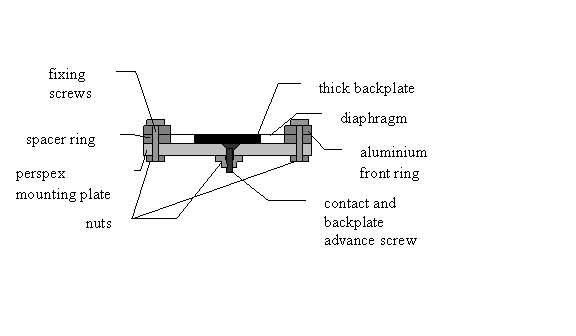


Loudspeaker design was the same as the experimental microphones of style B except that the mounting and backplates were proportionately larger and the diaphragm was 6um aluminised Mylar.
The backplate for the Rank microphone consists of a metal disc 11mm diameter, perforated with an array of 45 holes, 0.5mm diameter, spaced on a 1mm grid. The backplate is mounted in front of a 2.5mm deep cavity. The Holgate backplate is made from a solid block of metal 13mm diameter with 10 concentric grooves 0.25mm wide, 0.25mm apart and 0.25mm deep. The earlier brass microphones use a clock or watch balance wheel spring cemented to a perspex disc through which is drilled a small hole for the connecting wire. This produces a single helical rail with a width of 0.05mm and a spacing between turns of 0.5mm and a thickness of 0.5mm. The total diameter of the backplate is 13mm. Later brass microphones use discs of TV shadow mask material cemented to a perspex disc in the same way as the balance springs. This material consists of soft iron sheet 0.25mm thick, perforated with small holes. The holes are arranged in staggered rows 0.5mm apart, with the holes 0.7mm apart. The holes are conical in shape with a front diameter of 0.5mm and a rear diameter of 0.2mm. Backplate diameter in these microphones was approximately 17mm.
A number of sintered metal discs were also used as backplates for the experimental microphones. Three types of sintered bronze disc were obtained from Sintered Metal Products Ltd of Sutton in Ashfield, Notts.. These discs, from the Porosint range, are 12.7mm diameter, 3.3mm thick and of three different grades, A, C and E. Grade E is the coarsest and is specified as being able to pass particles with a maximum diameter of 37.5µm. Grade C would pass particles of 12.5µm and grade A, the finest of the three, would pass particles of 2.5µm. Sintered metal discs for use as filters in aqualungs were also tried. These have a diameter of 12.5mm, are 1.5mm thick and are of a similar particle size to the grade E Porosint discs, but with a less regular finish.
Electrical connection was made to the sintered discs by attaching a 6BA screw to the centre of the rear face of the disc with Elecolit 336 silver epoxy resin.
Results
Before calibrating microphones using the method of comparison with a primary standard, it was necessary to establish the characteristics of different loudspeakers that were available and to decide on a suitable one to use.
A number of possible transducers were available. An Ionophone, The Rank transducer, a microphone used in reverse or a specially constructed loudspeaker. The Ionophone loudspeakers were not considered suitable due to the fact that existing frequency response curves (Pye, pers comm) indicated the presence of several very sharply tuned peaks and nulls, making it very difficult to obtain repeatable results. Microphones used in reverse suffer from low power output at the lower frequencies since their output drops at a rate of 12dB/octave with decreasing frequency below the high frequency resonance of the microphone.
The frequency response of the Rank transducers is shown in Fig TR8 and it can be seen that this too suffers from a 12dB/octave drop in output at the low frequency end of the spectrum, and in addition has a deep, broad dip in the output between 50 and 150 kHz with a peak at 80 kHz.
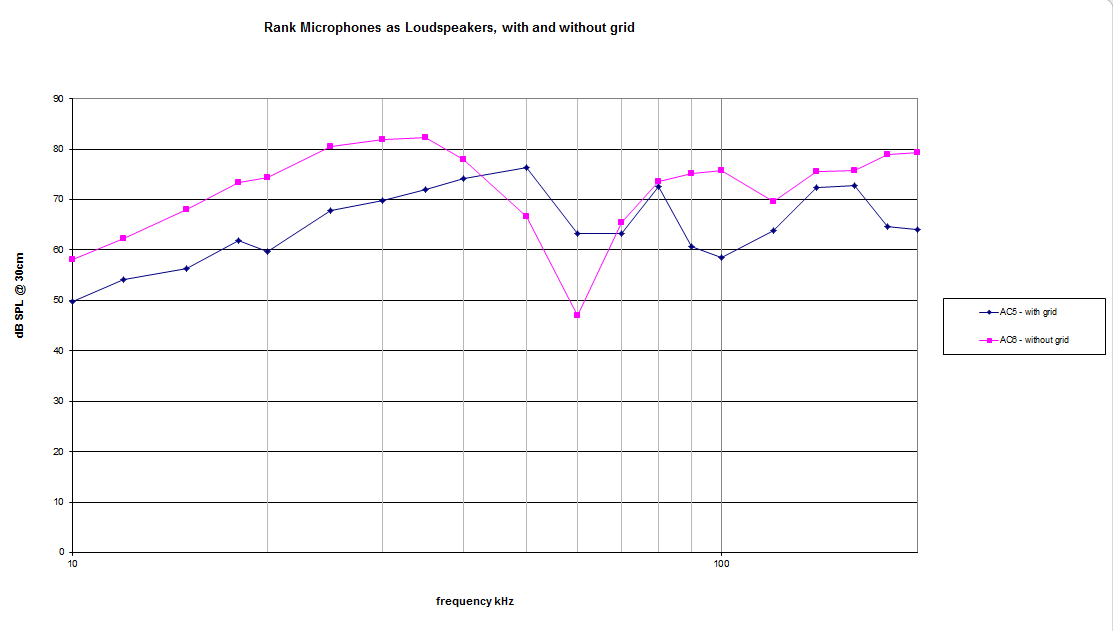
A purpose built loudspeaker was made to the same design as the microphones of style B, using 38mm diameter sintered metal backplate obtained from Micropore Ltd.. The characteristics of this loudspeaker are shown in Fig TR9. It can be seen that the response is flat above 40 kHz and only drops a little below 30 kHz. This is the loudspeaker which was chosen for microphone calibrations, although it was found that there was significant distortion at 10 kHz unless the loudspeaker was run at very low signal levels. For this reason it was necessary to carry out the 10kHz microphone calibrations with a sound field 10dB less than that used for the higher frequencies.
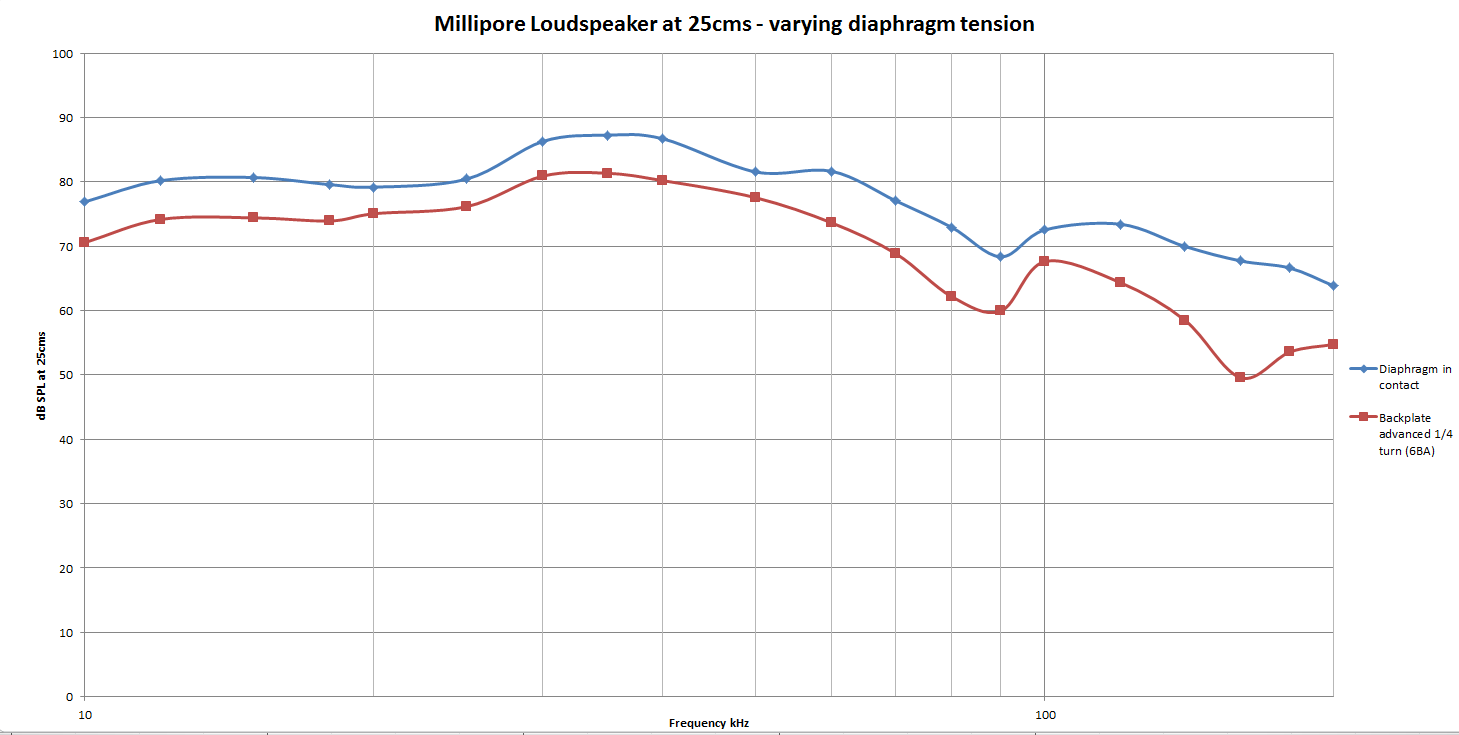
In 1975, Machmerth ^&et al\& described a loudspeaker with a response which was flat from 15-130 kHz, using a backplate with parallel grooves 0.5mm wide and 0.5mm apart. A loudspeaker of similar design to that using the sintered backplate was constructed using a brass backplate 30mm diameter, with parallel grooves 0.5mm wide and 0.5mm apart extending right across the plate. This gives a frequency response very similar to that of the sintered disc loudspeaker, except that there is a greater drop at low frequencies and the output is lower at the higher frequencies.
The effect of diaphragm tension on the response of loudspeakers was investigated using a microphone of style B with a backplate of grade A sintered bronze. The diaphragm was cemented to the front ring and heated gently to remove any wrinkles and to tension it. After assembly the backplate was adjusted so that there was just an even contact over the surface of the backplate. The frequency response was measured and then the backplate was advanced by turning the 6BA screw on which it was mounted by one half turn. The effect on the overall efficiency is small, the tighter diaphragm giving a lower efficiency, but it can be seen that there is a marked effect on the low frequency anti-resonance, which is far more pronounced with the higher diaphragm tension.
The frequency responses of several existing microphones were measured (Fig TR10)
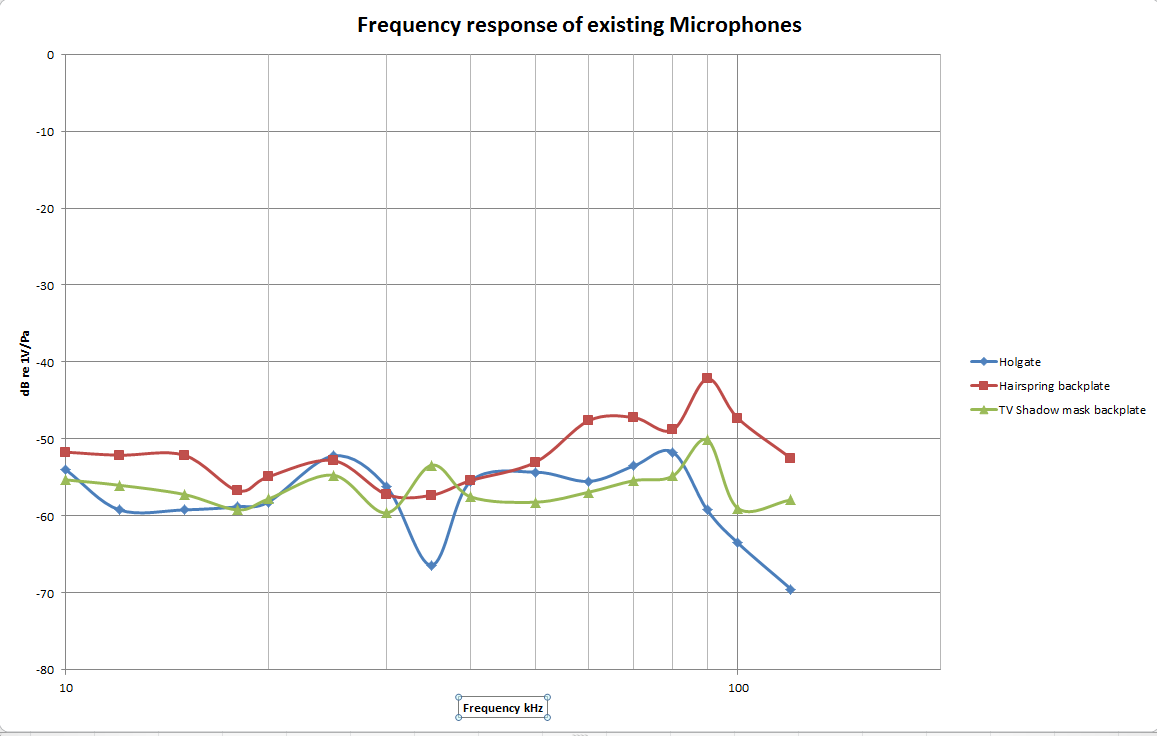
The Holgate microphone has a sensitivity of -75 dB re 1V/µbar (-55dB re 1V/Pa) with a high frequency resonance at 80 kHz, above which the sensitivity drops at 12 dB/octave. There is also a small peak in sensitivity at 25 kHz and a marked anti-resonance at 35 kHz.
Characteristics of the brass microphones with both types of backplate are similar, and show the same general pattern as the Holgate microphone.The h.f. resonance is slightly higher at 90 kHz and the anti-resonant dips are less marked, but these microphones are very variable, both from one microphone to another and for the same microphone after changing diaphragms. Over a range of eight microphones tested the h.f. resonance varied between 40 and 110 kHz, and the overall sensitivity ranged from -60 dB to -100 dB re 1V/µbar (-40 to -80dB re 1V/Pa). The magnitude of the antiresonance was also found to be quite variable, and could be as large as 15 dB.
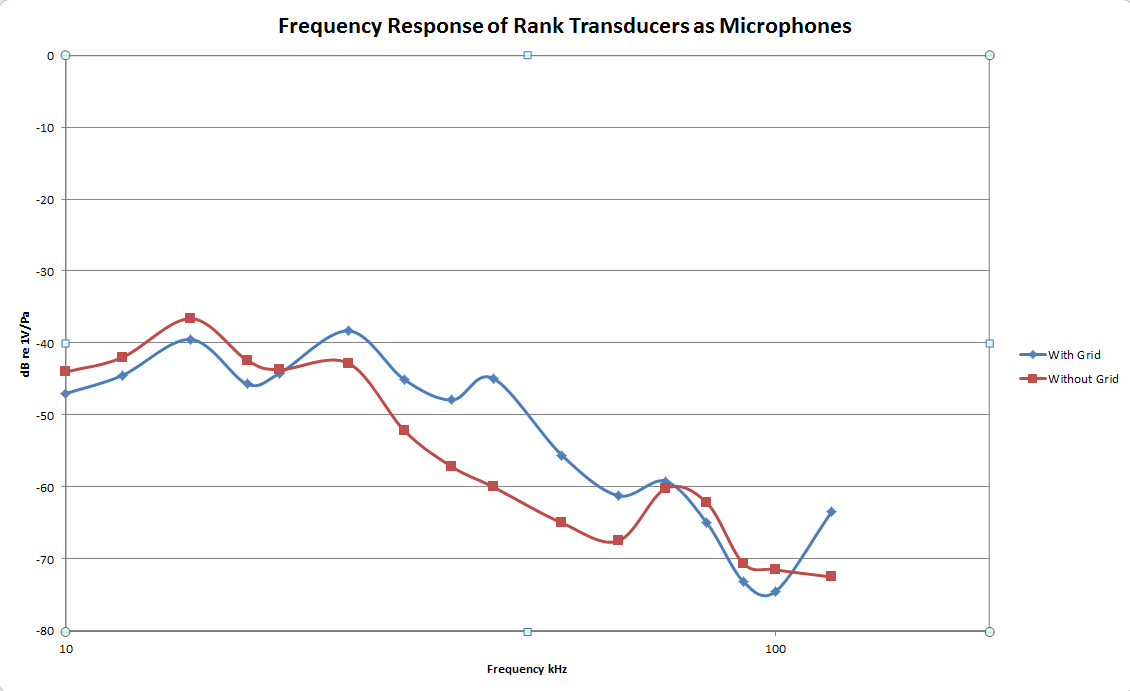
The Rank transducers have a very poor frequency response (Fig TR11) with a low frequency sensitivity of about -60 dB re 1V/µbar (-40dB re 1V/Pa), dropping off rapidly above 25 kHz with many peaks and dips. If the protective mesh is removed the shape of the response is the same but the peaks and dips are less pronounced. The peak at 70 kHz however is still prominent.
Experimental microphones of style A were fitted with backplates made from TV shadow mask material, and tested as loudspeakers to determine their general characteristics. They were found to be similar in their response to the brass microphones with the same style of backplates.
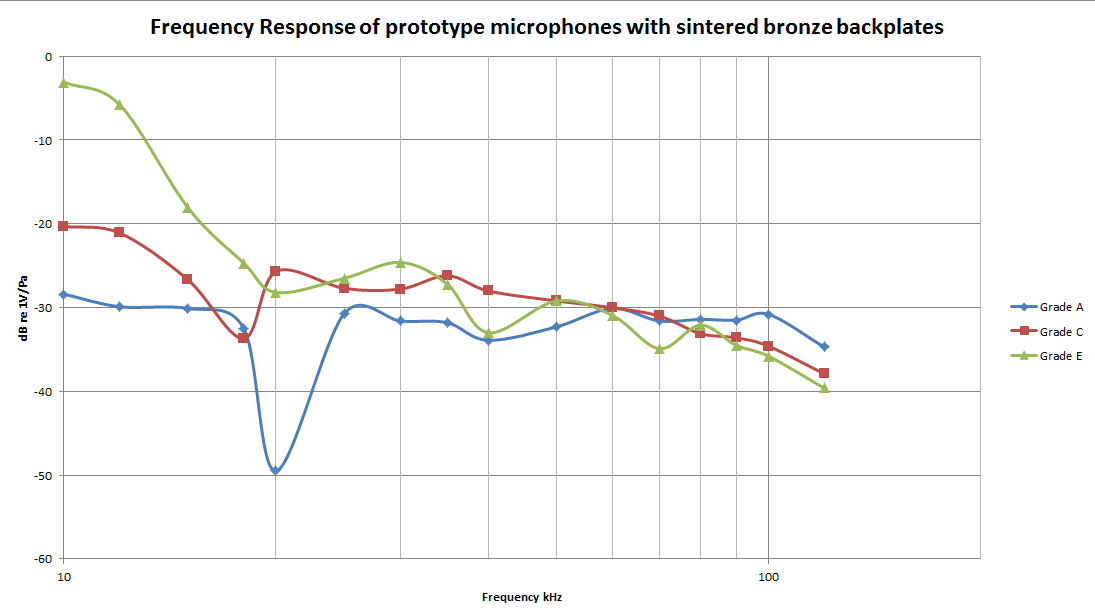
Sintered metal backplates were tested in experimental microphones of style B. Initial test were made with the microphones used as loudspeakers, to determine general trends, and they were later tested as microphones. The microphone responses with Porosint backplates of grades A C and E are shown in TR12. The coarsest grade of backplate (E) gives a response with a number of pronounced dips at 20, 40 and 70 kHz, and drops in sensitivity above 30 kHz. The medium grade disc (C) gives a flatter response with a sensitivity of -48 dB re 1v/µbar (-28dB re 1V/Pa), but with a sharp dip at 18 kHz and a high frequency resonance at 50 kHz. The finest grade, A, has a reasonable flat response up to 100 kHz, but the sensitivity is slightly lower than for the coarser grades and the anti-resonant dip at 20 kHz is very pronounced.
In view of these responses it was decided to concentrate on reducing the anti-resonant dip in the microphone with the finest grade of backplate, so as to maintain the best possible high frequency response at very small cost in overall sensitivity.
Although the shape of this frequency response is somewhat different to that of the WE640AA microphone, it can still be described by reference to the same equivalent circuit using the values shown in Fig TR13a. Fig TR13b shows the measured frequency response of this model, compared to the frequency response of one of the final production microphones.

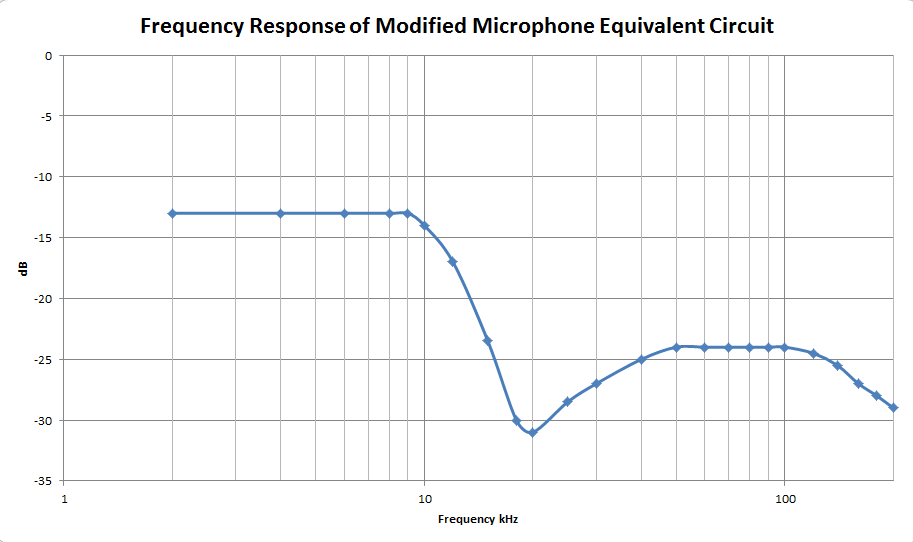
At low frequencies the impedance of MAA + MAD and MAS are negligible and the only effect is that of CA1 in parallel with CA2 forming a potential divider with CAS, giving a flat response. The first resonance to occur is due to MAA+MAD+MAS with CAS in series with a parallel combination of CA1 and CA2. CA1 is effectively in parallel with CA2 since one end is effectively earthed through MAA+MAD, which has a very small value compared to MAS. The anti-resonance at 20 kHz is due to the parallel resonance of MAS with CA1 and CA2 in series. Above this frequency the response levels out until it reaches the high frequency resonance due to MAA+MAD forming a series resonance with a parallel combination of CA1 and CA2 in series with CAS. Both of the resonant peaks are damped by RAA (although this is usually quite small) and by RAS, while the anti-resonance is only damped by RAS.
For microphones in which the diaphragm is supported, changes in the size of the backplate and diaphragm have little effect on the characteristics of the microphone. However, by drilling a shallow hole in the centre of the backplate, the resistance to diaphragm movement due to atmospheric pressure on the front of the diaphragm (MAA) is proportionately increased, thus damping the resonances in the frequency response.
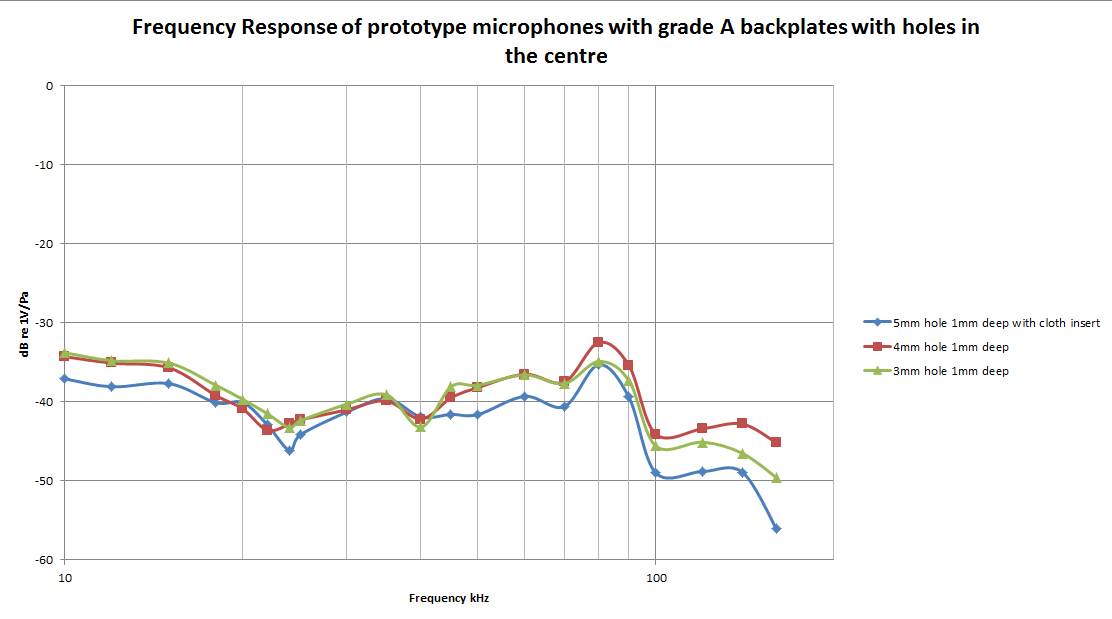
Holes 1mm deep, and of 3, 4 or 5mm diameter were machined in backplates of the finest grade (A) of sintered bronze. The responses of microphones using these backplates are shown in Fig TR14. In all three cases the low frequency resonances are less pronounced than with the solid backplates, although the h.f. resonances are more prominent and there is some loss in overall sensitivity. The size of the holes has little effect.
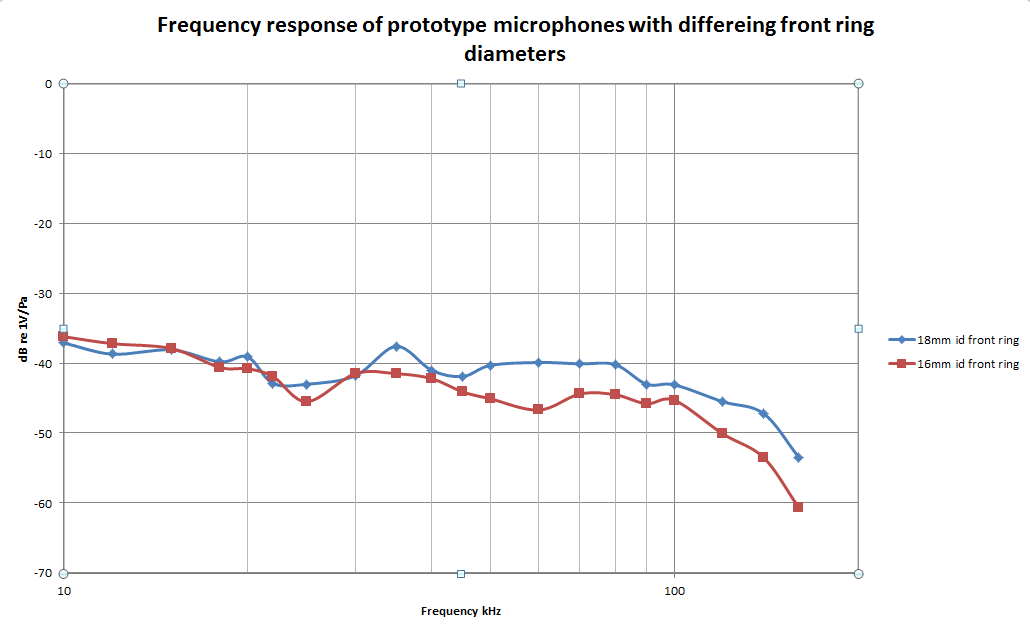
Fig 8 Frequency response of prototype microphones with differing front ring diameters.
Changing the diameter of the front ring has the effect of altering the area of the ‘dead’ part of the diaphragm, but this has little effect on the microphone responses (Fig TR15). Filling the central cavity with a small cloth pad also had little effect on the frequency response (Fig TR14).
The reason for the variation in the h.f. response of the microphones was not determined, but it is believed to be due to mechanical differences in the construction of the microphones, particularly in the diameter of the cavity into which the backplate fits, and possibly due to changes in atmospheric conditions between testing sessions. The effects of temperature, humidity and atmospheric pressure on the frequency responses have not been determined, although it has been reported (Pye pers. comm.) that storing the microphones in a desiccator improves their sensitivity.
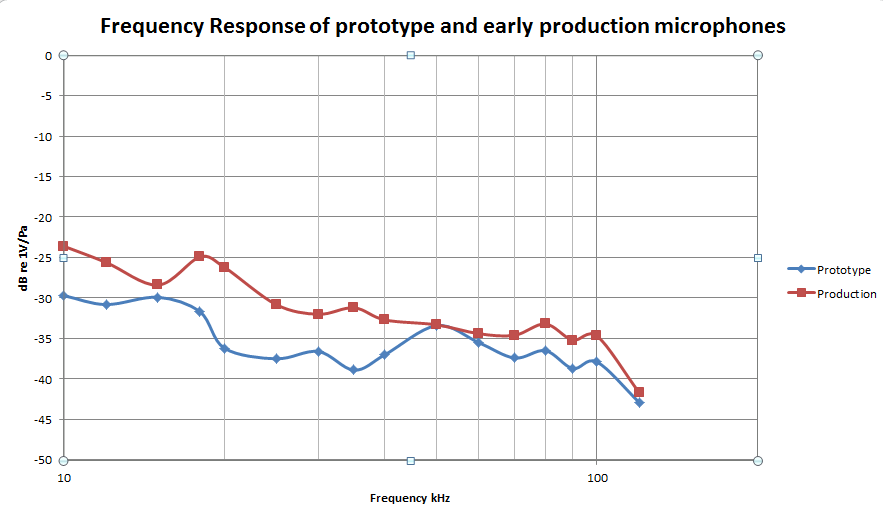
A pre-production prototype microphone was made using a grade A sintered bronze backplate with a 4mm diameter hole in the centre. The bottom of the hole was drilled through and countersunk so that an M3 countersunk screw could be used to attach the backplate to the mounting disc, leaving a hole 1-2mm deep. The depth of the recess in the mounting plate was such that the backplate just protruded, thus providing some diaphragm tension. Fig. TR16 shows the response of this microphone compared to the response of one of the first commercial production microphones. The overall sensitivity is -53 dB re 1V/µbar (-33dB re 1V/Pa) with an increase in sensitivity below 20 kHz and a 12 dB/octave roll off above 100 kHz.
During production a number of further changes were made to the design of the microphone, both to facilitate production and to improve microphone characteristics. In some of the early microphones the hole in the backplate was filled with Plasticine, although this treatment was later discontinued as the effect did not seem to be significant. Variation in the thickness of the backplate had a marked effect on diaphragm tension and therefore the rear face of each backplate was machined down until the front face of the backplate was flush with the mounting plate. In this condition the diaphragm was not in contact with the backplate in the absence of polarising voltage, but was pulled down into complete contact when the polarising voltage was applied.
Tension in the diaphragm is controlled by machining a rebate around the edge of the mounting plate over which the front ring fits, thus tensioning the diaphragm when the front ring is attached to the mounting plate.
A considerable improvement in the production microphones, both in sensitivity and in consistency was achieved by modifying the design of the front cap of the headstage so that it protrudes as little as possible in front of the face of the microphone. One further modification has been to reduce the size of the hole in the backplate, and to tap it so that the backplate can be held in place by a screw with the head behind the mounting plate, forming the contact. This greatly simplifies microphone manufacture.
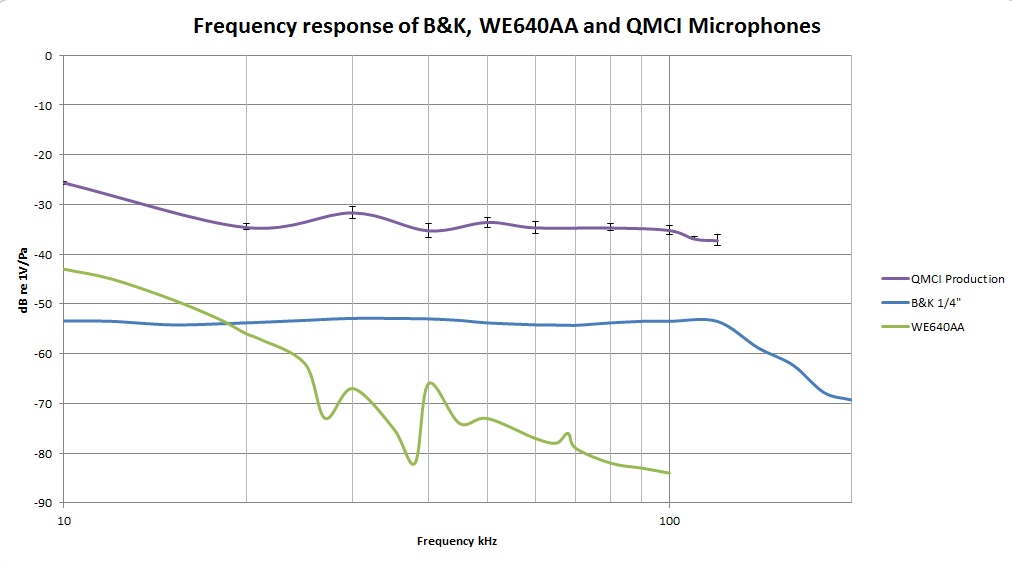
Production microphones have a sensitivity of -55 dB +/- 3 dB re 1V/µbar (-35dB +/- 3dB re 1V/pa) from 20 to 110 kHz, with a sensitivity of better than -70 dB (-50dB re 1V/Pa) at 180 kHz. The response of these microphones is shown in Fig TR17, where it is compared to the responses of the B&K ¼” and WE640AA microphones.
Discussion
The new, production microphone described here shows considerable improvement over earlier designs, having wide frequency response, good sensitivity and low cost. While it is not intended as a replacement for accurate calibrated microphones such as those made by Bruel and Kjaer it provides a cheap and robust tool for use in the field and laboratory.
The concepts involved in the design owe a great deal to earlier solid dielectric microphone designs, but many of the mechanical features were selected for ease of construction. Theoretical analysis may provide general guidelines for microphone design, but do not lead to a precise design due to the difficulty in quantifying many of the parameters.
Basic design parameters follow the observations of earlier workers (Machmerth et al 1975, Matsuzawa 1958, 1960, Kuhl et al 1954). The mass of the diaphragm should be kept as small as possible to maximise the high frequency response, but the effect of diaphragm tension is not entirely clear. This is largely due to the difficulty in constructing microphones with a consistent degree of tension, exacerbated by the fact that the diaphragm will be pulled against the backplate by the polarising voltage, which may produce localised regions of very high tension, while other areas may be comparatively slack.
Backplate design has a pronounced effect on the characteristics of a microphone. A very rough backplate will provide the diaphragm with a high degree of compliance leading to good overall sensitivity, but results in a poor high frequency response. A smoother backplate will move the high frequency resonance upwards, but at the expense of overall sensitivity. Backplate size has little effect on the high frequency response of a microphone, but if a good low frequency response is required from a capacitance loudspeaker, then a large backplate area will be needed (since only a small diaphragm displacement is possible). Directionality of a microphone will increase with backplate size, but it is generally more convenient to have a moderately non-directional microphone which can be made more directional by fitting a horn if desired.
The ability to detect sounds does not depend entirely on the sensitivity of the microphone., but is also a function of the noise generated by the headstage amplifier. Microphone noise is generally negligible for a capacitance microphone with a plastic diaphragm (Kuhl et al) but it has been observed that the microphone generated noise may become very pronounced in humid conditions (Pye pers comm). This noisy condition may be reversed by storing the microphone in a desiccator. Headstage amplifiers designed for use with the brass microphones used a low cost FET and an emitter follower with overall feedback, to give a gain of about 20 dB and a noise level of 19 mV at the input. A new headstage amplifier has been designed by P.K. Ward for use with the production microphones described here, which has a noise level of only 4 mV over the frequency range 10-180 kHz.
The combined effect of the new microphone and the new headstage resulted in an increase in sensitivity of 24 dB over the brass microphones and their headstages. Due to the effect of atmospheric attenuation at high frequencies this only leads to a doubling of the range at which a 40kHz bat could be detected. This however corresponds to an eightfold increase in the volume of space in which such a bat could be heard (Pye 1980).
There is still considerable room for improvement in the design of ultrasound microphones, although increasing sensitivity will give progressively less advantage. This is not only because of the effects of atmospheric attenuation, but also due to problems caused by acoustic noise in the vicinity of the microphone. Improvement of the consistency of response and sensitivity would be of great benefit, not least in the concomitant reduction in the rejection rate of production microphones. Early production microphones suffered from a rejection rate of nearly 50%, but the later design modifications reduced this to a rejection rate of only 10%. Further simplification of the microphone design could also significantly reduce manufacturing costs.
There is also room for improvement in the frequency response of the microphones, both by extending the top end of the frequency range, and by reducing the sensitivity to low frequency sounds, which are generally unwanted and can mask faint ultrasonic sounds. Low frequency sensitivity can also lead to problems with acoustic feedback in bat detectors.
One development which would be of great convenience would be to eliminate the need for a polarising voltage generator, which is bulky, electrically noisy, and inefficient. This could be achieved by using the electret principle (Sessler and West 1966, 1968, 1969, 1973, Gross 1971, Wintle 1973). In an electret microphone the polarising charge is bonded to the material of the dielectric, typically by bombarding the dielectric material with electrons at a potential of about 30 kV (Wintle 1973). The most suitable material for the production of an electret is polytetrafluorethylene (PTFE) and its derivatives, but due to the non-stick nature of these materials it is difficult to produce them in the form of thin metallised films. This problem can be overcome by coating the backplate with a thin layer of the dielectric, and then to use a thin metal diaphragm or aluminised Mylar with the metal side inwards (Killion and Carlson 1974). The technical complexity of manufacturing microphones of this type could, however, only be justified by very high volumes of sales.
The characteristics of the production microphone described here are such that, in conjunction with the Ward headstage, it has already found widespread use amongst those working with airborne ultrasound. Its robustness and sensitivity make it ideal for use in the field, while it is complemented in the laboratory by the calibrated B&K microphones for accurate quantitative work. Its low cost, and ease of replacement make it eminently suitable for use in situations where it is likely to be damaged, such as when used in proximity to small rodents.
Calibrations of the Pye brass microphones, and the QMC S100 microphones, as well as some general information on the construction of home-made ultrasonic microphones has been published in the Proceedings of the Institute of Acoustics 26(5) 2004.
Bibliography
Ballantine, Stuart. 1929. “Reciprocity in electromagnetic, mechanical, acoustical and interconnected systems.” Proceedings of the Institute of Radio Engineers 17 (6): 927-951.
Beranek, L. 1954. Acoustics. American Institute of Physics.
Ellison, A. J. and Miller, B. B. 1963. “Design and construction of the anechoic chamber at Queen Mary College.” Proceedings of the Institution of Mechanical Engineers 178: 53-68.
Foldy, L. L. and H. Primakoff. 1945. “A General theory of passive linear electroacoustic transducers and the electroacoustic reciprocity theorem. I.” The Journal of the Acoustical Society of America 17: 109.
Griffin, Donald R. 1958. Listening in the Dark. Yale University Press.
Gross, B. 1971. “Electrets.” Endeavour.
Halls, J. A. T. 2004. “A Comparison of Backplate Designs for Homemade Microphones For Airborne Ultrasound.” Proceedings of the Institute of Acoustics 26 (5).
Killion, M. C., and Carlson, E. V. 1974. “A subminiature electret condenser microphone of new design.” Journal of the Audio Engineering Society 22: 237-243.
Kuhl, W., Schodder, G. R. and Schroeder, F. K. 1954. “Condenser transmitters and microphones with solid dielectric for airborne ultrasonics.” Acustica 4: 519-532.
Machmerth, H., Theiss, D. and Schnitzler, H.U. 1975. “Konstruktion eines luftultraschallgebers mit knostantem frequenzgang im bereich von 15kHz bis 130kHz.” Acustica 34: 81-85.
MacLean, W. R. 1940. “Absolute measurement of sound without a primary standard.” The Journal of the Acoustical Society of America 12: 140-146.
Matsuzawa, K. 1958. “Condenser microphones with plastic diaphragms for airborne ultrasonics.” Journal of the Physical Society of Japan 13: 1533-1543.
McCue, J. J. G., and Bertolini, A. 1964. “A portable receiver for ultrasonic waves in air.” Institute of Electrical and Electronics Engineers Transactions, Sonics and Ultrasonics SU-11: 41-49.
Noyes, A. and G. W. Pierce. 1938. “Apparatus for acoustic research in the supersonic frequency range.” Journal of the Acoustical Society of America 9: 207-211.
Pierce, George Washington. 1949. The Songs of Insects. Harvard University Press.
Pye, J. D. and Flinn, M. 1964. “Equipment for detecting animal ultrasound.” Ultrasonics 2: 23-28.
Pye, J. D. 1980. “Bat Detection.” IEE Review 26 (5): 376-380.
Rudnick, I and M. N. Stein. 1948. “Reciprocity free field calibration of microphones to 100Kc in air.” The Journal of the Acoustical Society of America 20 (6): 818-825.
Sessler, G. M., and West, J. E. 1964. “Condenser microphones with electret foil.” Journal of the Audio Engineering Society 12 (2): 129-131.
Sessler, G. M., and West, J. E. 1973. “Electret transducers, a review.” Journal of the Acoustical Society of America 53 (6).
Sessler, G. M., and West, J. E. 1966. “Foil-electret microphones.” Journal of the Acoustical Society of America 40 (6).
Sessler, G. M., and West, J. E. 1972. “Production of high quasipermanent charge densities on polymer foils by application of breakdown fields.” Journal of Applied Physics 43 (3).
Sessler, G. M., and West, J. E. 1962. “Self-biased condenser microphones with high capacitance.” Journal of the Acoustical Society of America 34: 1787-1788.
Stuart Parsons, Arian M Boonman and Martin K Obrist. 2000. “Advantages and Disadvantages of Techniques for Transforming and Analyzing Chiropteran Echolocation calls.” Journal of Mammalogy 81 (4): 927-938.
Wintle, H. J. 1973. “Introduction to electrets.” Journal of the Acoustical Society of America 53.

